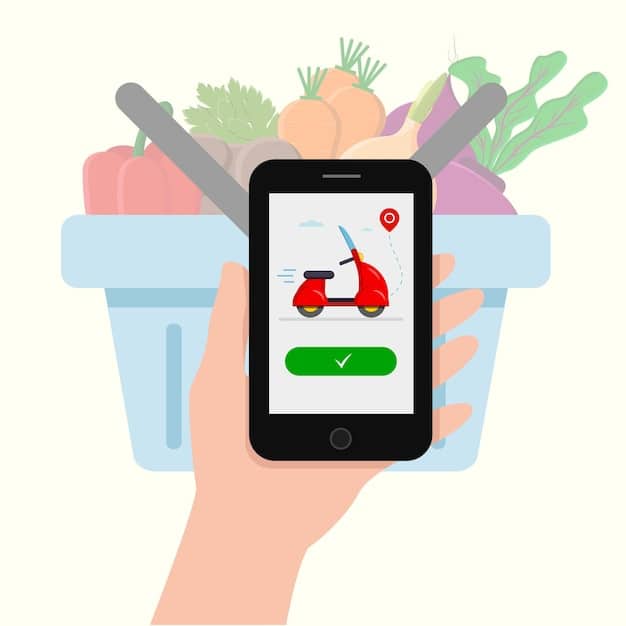Grocery Delivery: Is It Worth the Cost? A Data-Driven Analysis

Is It Worth It? A Data-Driven Analysis of Grocery Delivery Services and Their Impact on Your Budget explores the financial implications of using grocery delivery apps, weighing convenience against the potential costs to help consumers make informed decisions.
In today’s fast-paced world, convenience often comes at a price. With numerous grocery delivery services vying for our attention, it’s crucial to evaluate whether the added convenience genuinely justifies the expense. Let’s delve into a data-driven analysis of grocery delivery services and their impact on your budget to determine if they’re truly worth it.
The Rise of Grocery Delivery Services
Grocery delivery services have exploded in popularity, transforming how many of us shop for food. These services promise to save time and effort, allowing customers to order groceries online and have them delivered directly to their doorsteps. Let’s examine the factors driving this trend and the allure of on-demand grocery shopping.
Factors Fueling the Grocery Delivery Boom
Several factors contribute to the increasing demand for grocery delivery. Busy lifestyles, technological advancements, and the desire for convenience are major drivers. The COVID-19 pandemic further accelerated the adoption of these services, as people sought to minimize their exposure in public spaces.
The Appeal of On-Demand Grocery Shopping
On-demand grocery shopping offers several benefits, including time savings, reduced impulse purchases, and access to a wider variety of products. For individuals with limited mobility or those who live in areas with limited grocery store access, delivery services can be a lifeline.

Grocery delivery services have dramatically altered the landscape of retail, providing customers with unparalleled expediency. From tackling hectic schedules to easing mobility difficulties, the advantages are undeniable. However, it’s necessary to weigh whether these conveniences outweigh the expenses.
Breaking Down the Costs: Beyond the Grocery Bill
When evaluating the true cost of grocery delivery, it’s essential to look beyond the price of the groceries themselves. Delivery fees, service charges, tipping, and potential markups can all add to the final bill. Understanding these hidden costs is crucial for making an informed decision.
Delivery Fees and Service Charges
Most grocery delivery services charge delivery fees, which can vary depending on factors such as distance, order size, and delivery time. Some services also impose service charges, which are typically a percentage of the order total. These fees can significantly increase the cost of each delivery.
The Impact of Tipping
Tipping is another factor to consider when calculating the total cost of grocery delivery. While not always required, tipping delivery drivers is customary in many areas. The amount of the tip can add substantially to the bill, especially for larger orders.
Markups on Grocery Items
Some grocery delivery services mark up the prices of individual items compared to what you would pay in-store. These markups can be subtle but can add up over time, especially if you frequently use the service. Comparing prices between the delivery service and your local grocery store can help you identify potential markups.
- Delivery fees are usually predictable but can vary based on demand.
- Service charges are commonly a percentage and might not be immediately obvious.
- Tipping, even if optional, is often factored into the perceived cost.
- Markups are the most insidious, slowly inflating the overall expenditure.
It’s essential to carefully analyze all these costs to obtain a comprehensive view of grocery delivery expenses, allowing for more informed budgeting and choices.
Potential Savings Through Grocery Delivery
While grocery delivery services can add to your expenses, they also offer opportunities for savings. By carefully planning your orders, taking advantage of promotions, and avoiding impulse purchases, you can potentially reduce your grocery bill with these services.
Strategic Order Planning
Planning your grocery orders in advance can help you avoid unnecessary purchases and reduce the likelihood of impulse buys. Creating a detailed shopping list and sticking to it can help you stay within your budget.
Leveraging Promotions and Discounts
Many grocery delivery services offer promotions and discounts to attract new customers and retain existing ones. Keep an eye out for deals such as free delivery, percentage discounts, and cashback offers. Subscribing to email newsletters and following the service on social media can help you stay informed about the latest promotions.
Avoiding Impulse Purchases
One of the key benefits of grocery delivery is that it can help you avoid impulse purchases. By shopping online, you’re less likely to be tempted by strategically placed displays and enticing promotions in the store. This can lead to significant savings over time.

Although upfront costs might seem high, strategic planning and usage of promotions can drastically offset these expenses, making grocery delivery a viable option for budget-conscious consumers.
Comparing Costs: DIY vs. Delivery
To determine whether grocery delivery services are worth the cost, it’s essential to compare the total cost of using these services with the cost of shopping for groceries yourself. This comparison should take into account factors such as time, transportation costs, and opportunity costs.
Calculating the True Cost of DIY Grocery Shopping
DIY grocery shopping involves more than just the cost of the groceries themselves. You also need to factor in the time spent traveling to and from the store, the cost of transportation (gas, public transit, etc.), and the opportunity cost of your time. The opportunity cost represents the value of what you could have been doing with your time instead of grocery shopping.
Assessing the Total Cost of Delivery Services
The total cost of delivery services includes delivery fees, service charges, tipping, potential markups, and any subscription fees. To get an accurate picture of the cost, track your spending on grocery delivery over a period of time and compare it to what you would have spent on DIY grocery shopping.
- Consider the round-trip commute to the grocery store, including traffic.
- Account for wear and tear on your vehicle or the cost of public transportation.
- Estimate the opportunity cost of your time based on your hourly rate or personal value.
By directly comparing these figures, you can more objectively evaluate whether grocery delivery aligns with your financial goals and provides worthwhile value.
Subscription Models: Unlocking Potential Savings
Many grocery delivery services offer subscription models that can unlock potential savings for frequent users. These subscriptions typically involve paying a monthly or annual fee in exchange for benefits such as free delivery, reduced service charges, and exclusive promotions. Let’s explore how these models can impact your budget.
Evaluating Subscription Benefits
Before signing up for a subscription, carefully evaluate the benefits offered and consider whether they align with your shopping habits. If you frequently use the service and take advantage of the included perks, a subscription can be a cost-effective option. However, if you only use the service occasionally, the subscription fee may not be worth it.
Calculating the Break-Even Point
To determine whether a subscription is right for you, calculate the break-even point. This is the number of orders you need to place each month or year to offset the cost of the subscription. If you consistently exceed the break-even point, a subscription is likely a good value. If you fall short, you may be better off paying for deliveries on a per-order basis.
Subscription models can offer considerable savings for frequent users by bundling services into a set fee. Determining whether the volume of use offsets the upfront subscription cost is essential to reaping the benefits.
Making the Decision: Is Grocery Delivery Worth It for You?
Ultimately, the decision of whether grocery delivery is worth it depends on your individual circumstances and priorities. Factors such as your budget, lifestyle, and personal preferences will all play a role in your decision-making process. Let’s consider some scenarios to help you determine if grocery delivery is right for you.
Factors to Consider
When making your decision, consider the following factors: your budget, your time constraints, the availability of grocery stores in your area, your mobility, and your personal preferences. If you’re on a tight budget or have ample time for grocery shopping, DIY grocery shopping may be the more economical option. However, if you’re short on time or have limited mobility, grocery delivery services may be a worthwhile investment.
Scenarios and Recommendations
Consider these scenarios:
- Scenario 1: Busy professional with limited time: Grocery delivery may be worth it for the time savings and convenience.
- Scenario 2: Budget-conscious student: DIY grocery shopping is likely the more economical option.
- Scenario 3: Individual with limited mobility: Grocery delivery can provide a valuable service and may be worth the cost.
Ultimately, whether grocery delivery is worth it hinges on individual needs and a careful examination of one’s financial and lifestyle conditions, enabling personalized choices.
| Key Point | Brief Description |
|---|---|
| ⏱️ Time Savings | Grocery delivery saves significant time compared to traditional shopping. |
| 💰 Cost Factors | Consider delivery fees, service charges, tipping, and item markups. |
| 🛒 Impulse Control | Online shopping can reduce impulse purchases, potentially saving money. |
| 🎯 Subscription Value | Evaluate subscription benefits based on your shopping frequency. |
Frequently Asked Questions
▼
Yes, they often are. Delivery fees, service charges, and potential markups on items can make them pricier than DIY shopping.
▼
Plan your orders, use promotions, and avoid impulse purchases. Subscription models may also offer savings if you shop frequently.
▼
While not always mandatory, tipping is customary in many regions and should be factored into the total cost.
▼
Yes, many grocery delivery services offer subscription models with benefits such as free or reduced delivery fees.
▼
Opportunity costs include the value of the time spent shopping, which could have been used for other productive activities.
Conclusion
Determining whether grocery delivery services are worth it requires careful consideration of your personal circumstances, budget, and lifestyle. By weighing the costs and benefits and exploring strategies to minimize expenses, you can make an informed decision that aligns with your financial goals.





